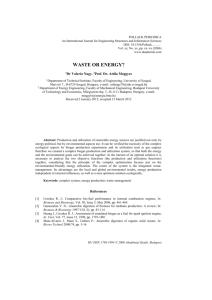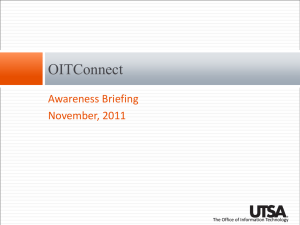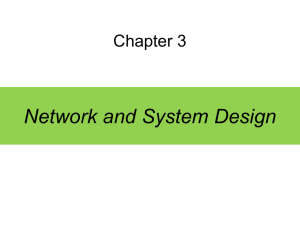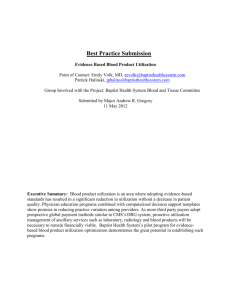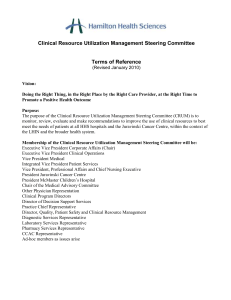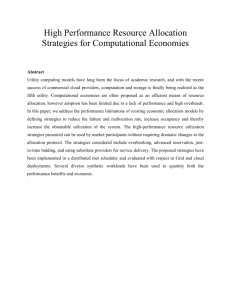Chapter 8 - Towson University
advertisement
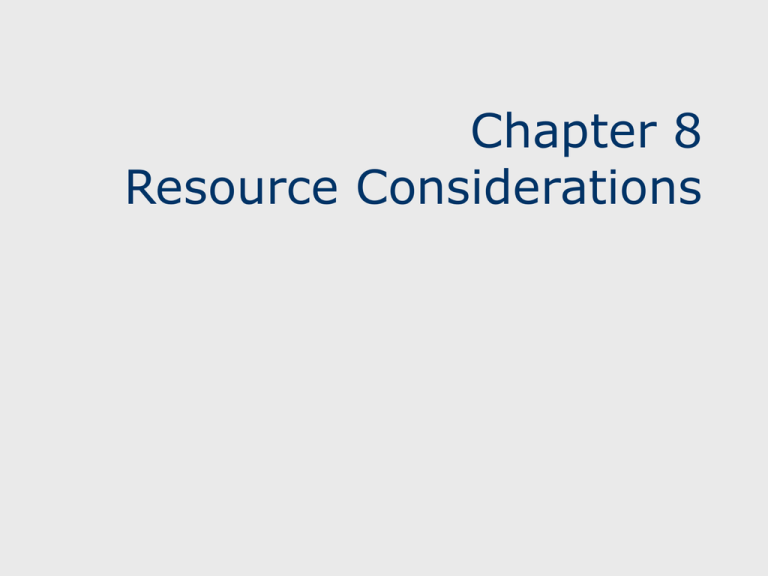
Chapter 8 Resource Considerations Learning Objectives Learn how to take resource constraints into account Determine the planned resource utilization for a project Level the use of resources within the required time frame Determine the shortest project schedule with limited resources 2 Real World Example Vignette: Resource-Constrained Health Services Planning The Ghana Community-based Health Planning and Services (CHPS) initiative was designed to translate the information resulting from an experimental study of the Navrongo Health Research Centre (NHRC). In 1990, despite “health for all” policy, over 70% lived more than 8 kilometers from nearest provider Rural infant mortality was 50% higher than in urban areas As a direct response to the need for health care reform, a phased research project was initiated to aide in changing the system from a clinical facility-focused approach to a community-based approach. By 1997, evidence had shown that the Navrongo project experiment was having a measurable impact. Consequently, fertility and mortality began to decline. 3 Real World Example Vignette: West Virginia University Resource Planning West Virginia University (WVU) relies heavily on its Office of Information Technology (OIT) to implement new systems, perform technology upgrades, maintain legacy systems, build communication networks, and deliver new online services. In the past the staff was divided into individual teams that created proposals for submission to a central committee for approval. OIT decided to implement IBM’s Rational Portfolio Manager. System was ineffective; caused over-tasked teams & missed deadlines. Hard to estimate and manage IT project needs; evaluate project portfolio status and costs; & tell if approved projects had enough resources. Three goals: (1) better resource planning and utilization; (2) easy access to project portfolio status; and (3) accurate IT cost determination. Its implementation has resulted in significant improvements to a number of IT. 4 Resource-Constrained Planning Nearly all projects have limits on available resources. Project delays often occur due to certain resources being unavailable. A network diagram can be drawn to reflect the availability of a limited number of resources. 5 6 Planned Resource Utilization It’s necessary to indicate the amounts and types of resources needed to perform each activity. Resource utilization based on each activity’s earliest start time are based on an as-soon-as-possible (ASAP) schedule. Resource utilization charts based on each activity’s latest start time are based on an as-late-as-possible (ALAP) schedule. 7 An ASAP chart - Unless indicated otherwise, always assume the chart is ASAP! 8 Resource Leveling Resource leveling, or smoothing, is a method for developing a schedule that attempts to minimize the fluctuations in requirements for resources. This method levels the resources so that they are applied as uniformly as possible without extending the project schedule beyond the required completion time. Trial-and-error method Delay non-critical activities beyond earliest start time 9 10 Resource-Limited Scheduling Resource-limited scheduling is a method for developing the shortest schedule when the number or amount of available resources is fixed and cannot be exceeded. This method will extend the project completion time if necessary in order to keep within the resource limits. Iterative method Allocate resources based on priority (least slack, etc.) 11 12 Assume limited to 2 painters! 13 14 15 16 Project Management Software Provides excellent features for handling resource considerations within a project. Allows you to create and maintain a list of resources. Resources can be assigned to various tasks within a project. The user is informed if any resources have time conflicts or if they are over-allocated. Numerous resource allocation reports can be generated. 17





